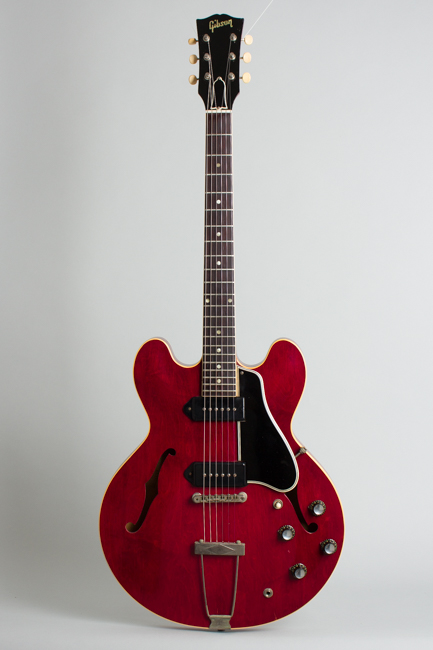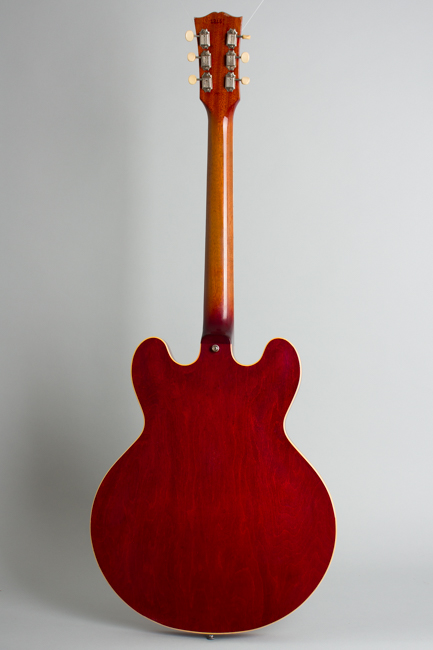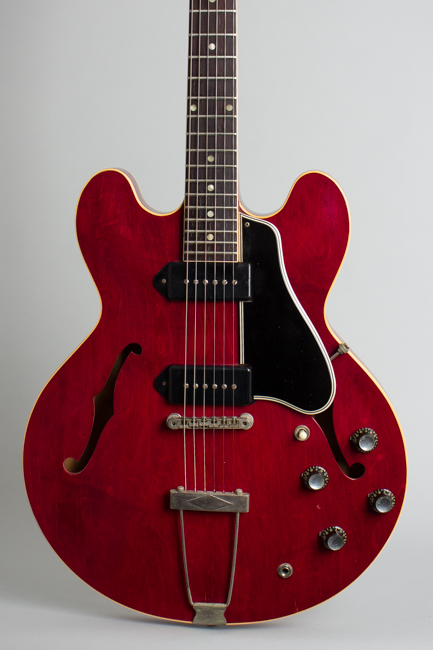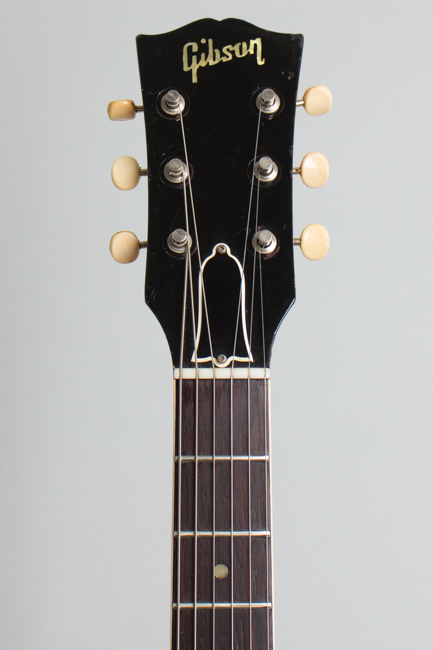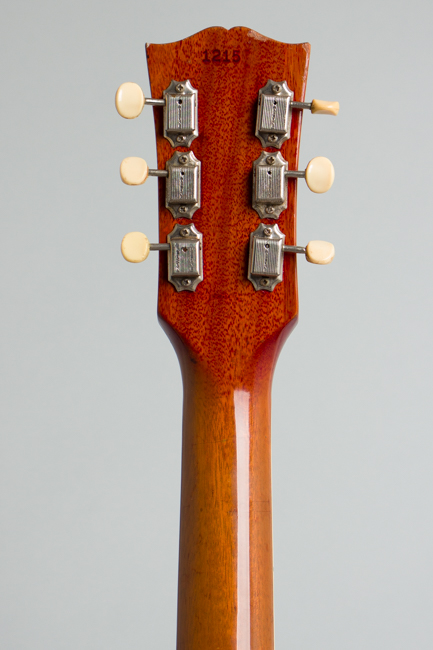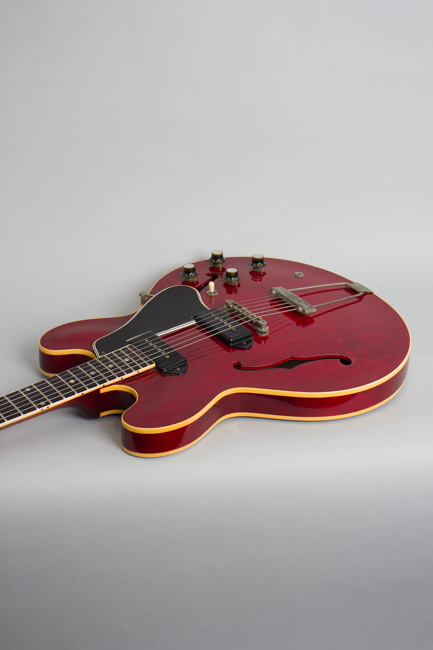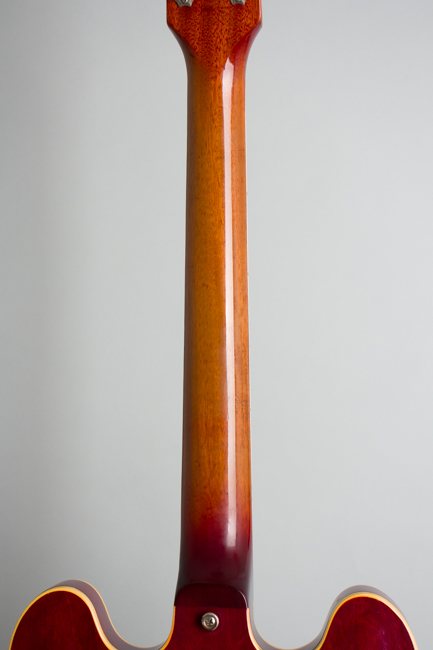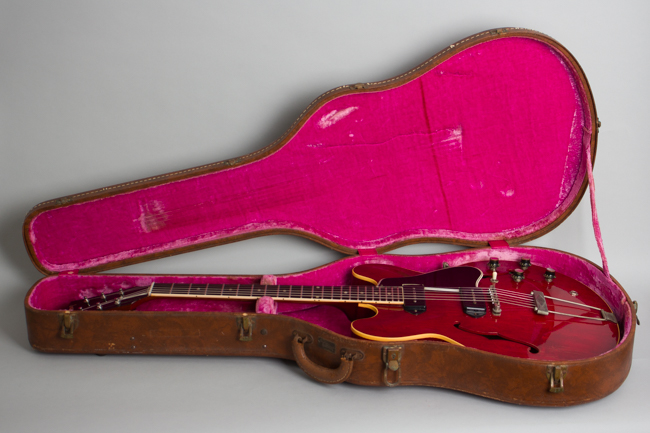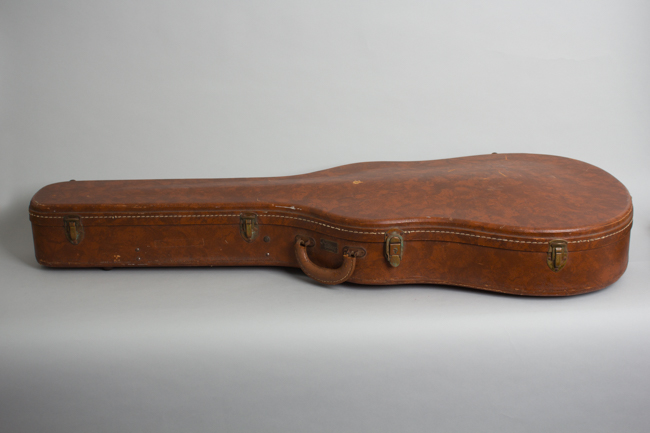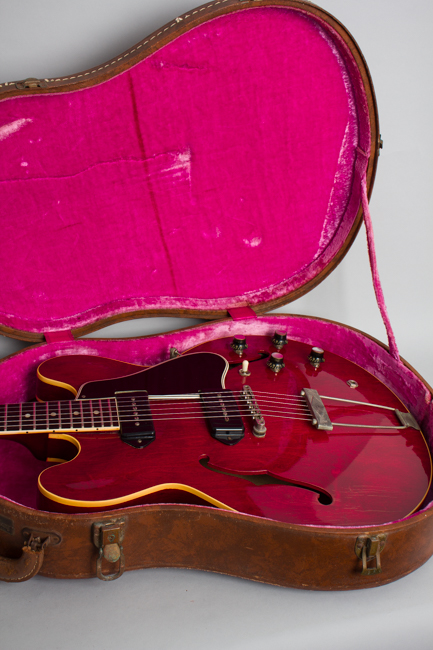Gibson ES-330TDC Thinline Hollow Body Electric Guitar (1961)
Gibson ES-330TDC Model Thinline Hollow Body Electric Guitar (1961), made in Kalamazoo, Michigan, serial # 1215, cherry lacquer finish, laminated maple body, mahogany neck, rosewood fingerboard, original brown hard shell case.
This is a super example of a first-generation cherry finish ES-330TDC from early 1961, the model's second production year in this finish. It retains all the earliest features including a bound dot-inlaid rosewood fingerboard, rounder "Mickey Mouse" cutaway horns and black plastic P-90 pickup covers. The unfaded cherry finish (a fairly new option at the time) has a deeper, darker hue than the typical mid-60s examples. The serial number impressed on the back of the headstock is a VERY low 4 digit example, one of the earliest we have seen from the first few days this system was in use. There is still a date-coded Factory Order Number ink-stamped under the treble side F-hole, something that would disappear soon after this one was made.
The ES-330T And ES-330TD debuted in late 1959 as lower-budget additions to the ES-335 line launched the year before. The initial announcement in the October/November '59 GIBSON GAZETTE described them as "Thrilling modern instruments...Double cutaway body and thin silhouette make it wonderfully east to hold and play". The single pickup 330T only lasted into the early 1960s, but the more versatile double pickup "TD" prospered. The originally offered natural finish variant was supplanted by this cherry option in mid-1960, and it quickly became quite popular.
In 1961 645 of these cherry finish, two pickup 330s were shipped out of Kalamazoo priced at $250 (plus case). This was not an huge quantity for the early '60s but the ES-330 was in any case regarded as a very successful model as it would remain for much of the 1960s. This guitar was purchased with the pink-lined brown hard shell case that was not often seen with these guitars as it added a whopping $60 to the price; most folks settled for chipboard! This case was also standard for the ES-335-and 345 so is a collectible in its own right today.
This 1961 ES-330TD has a classic set of mid-line Gibson features, but a distinctive feel. While grouped with the thin-line semi-solid 335 range this is actually a very different instrument to play. The slim single-bound body is fully hollow making it much lighter and more resonant than its sisters with a solid center block. This also led to another distinguishing feature of the 330, the neck joining the body farther in at the 16th fret to allow the joint to be stronger.
The neck profile on this guitar is the slim, flatter 1960 style, a feature specific to this period. This one has a rounder back with a shade more "meat" to it than some 1960s. The headstock has just a pearl Gibson logo, the tuners are single-unit enclosed Kluson deluxe with plastic buttons. The two P-90 pickups are mounted under black plastic dog-ear covers, which would be replaced with metal the next year. They are controlled by the standard Gibson 4-knob one switch wiring rig, with the then-new metal-capped plastic bonnet knobs.
Despite being intended as "amateur" instruments early ES-330TDs are great-sounding, extremely versatile guitars that have been heard live and on record in many styles of music. Jazz great Grant Green used this model extensively on his most well-regarded early 1960s recordings, while Slim Harpo relied on one for his deep swamp blues. The ES-330 and its nearly identical sister the Epiphone Casino were featured by countless '60s British invasion bands, including the Beatles, Rolling Stones, Kinks, Manfred Mann, and many more. Now, as then this is a very light and handy guitar with a killer feel and sound.
Overall length is 39 3/4 in. (101 cm.), 16 in. (40.6 cm.) wide at lower bout, and 1 3/4 in. (4.4 cm.) in depth, measured at side of rim. Scale length is 24 3/4 in. (629 mm.). Width of nut is 1 11/16 in. (43 mm.).
Overall this is a nicely clean and original guitar, showing some light wear for its 60+ years on the planet with one minor restoration but no notable damage or repair. The original finish is mostly very clean with virtually no fade and only some light checking. Overall there is light scuffing and small dings and dents, with heavier scratching on the back and some larger dinks to the headstock edges. The back of the neck has faded from hand contact as these tend to , but has little in the way of feelable wear.
Overall the guitar remains nicely original, including the black-covered P-90 pickups, wiring, knobs, switch, tailpiece and pickguard. The tuners were something else at some point, but have been neatly restored to the exact correct single-line Klusons, leaving only light pressure rings on the headstock as evidence. For some reason the nickel plating on the bridge and tailpiece is more heavily worn than the rest of the guitar. A period Gibson metal strap button was added at the heel, which is almost ubiquitous on old 330's.
The original frets remain in excellent shape, recrowned recently with no subsequent wear. This is a simply superb playing and sounding guitar, very light and super comfortable. It is equipped the original brown HSC, which appears to have never have held any other guitar showing only the "tuner marks" of this shorter neck. Overall Excellent Condition.
This is a super example of a first-generation cherry finish ES-330TDC from early 1961, the model's second production year in this finish. It retains all the earliest features including a bound dot-inlaid rosewood fingerboard, rounder "Mickey Mouse" cutaway horns and black plastic P-90 pickup covers. The unfaded cherry finish (a fairly new option at the time) has a deeper, darker hue than the typical mid-60s examples. The serial number impressed on the back of the headstock is a VERY low 4 digit example, one of the earliest we have seen from the first few days this system was in use. There is still a date-coded Factory Order Number ink-stamped under the treble side F-hole, something that would disappear soon after this one was made.
The ES-330T And ES-330TD debuted in late 1959 as lower-budget additions to the ES-335 line launched the year before. The initial announcement in the October/November '59 GIBSON GAZETTE described them as "Thrilling modern instruments...Double cutaway body and thin silhouette make it wonderfully east to hold and play". The single pickup 330T only lasted into the early 1960s, but the more versatile double pickup "TD" prospered. The originally offered natural finish variant was supplanted by this cherry option in mid-1960, and it quickly became quite popular.
In 1961 645 of these cherry finish, two pickup 330s were shipped out of Kalamazoo priced at $250 (plus case). This was not an huge quantity for the early '60s but the ES-330 was in any case regarded as a very successful model as it would remain for much of the 1960s. This guitar was purchased with the pink-lined brown hard shell case that was not often seen with these guitars as it added a whopping $60 to the price; most folks settled for chipboard! This case was also standard for the ES-335-and 345 so is a collectible in its own right today.
This 1961 ES-330TD has a classic set of mid-line Gibson features, but a distinctive feel. While grouped with the thin-line semi-solid 335 range this is actually a very different instrument to play. The slim single-bound body is fully hollow making it much lighter and more resonant than its sisters with a solid center block. This also led to another distinguishing feature of the 330, the neck joining the body farther in at the 16th fret to allow the joint to be stronger.
The neck profile on this guitar is the slim, flatter 1960 style, a feature specific to this period. This one has a rounder back with a shade more "meat" to it than some 1960s. The headstock has just a pearl Gibson logo, the tuners are single-unit enclosed Kluson deluxe with plastic buttons. The two P-90 pickups are mounted under black plastic dog-ear covers, which would be replaced with metal the next year. They are controlled by the standard Gibson 4-knob one switch wiring rig, with the then-new metal-capped plastic bonnet knobs.
Despite being intended as "amateur" instruments early ES-330TDs are great-sounding, extremely versatile guitars that have been heard live and on record in many styles of music. Jazz great Grant Green used this model extensively on his most well-regarded early 1960s recordings, while Slim Harpo relied on one for his deep swamp blues. The ES-330 and its nearly identical sister the Epiphone Casino were featured by countless '60s British invasion bands, including the Beatles, Rolling Stones, Kinks, Manfred Mann, and many more. Now, as then this is a very light and handy guitar with a killer feel and sound.
Overall length is 39 3/4 in. (101 cm.), 16 in. (40.6 cm.) wide at lower bout, and 1 3/4 in. (4.4 cm.) in depth, measured at side of rim. Scale length is 24 3/4 in. (629 mm.). Width of nut is 1 11/16 in. (43 mm.).
Overall this is a nicely clean and original guitar, showing some light wear for its 60+ years on the planet with one minor restoration but no notable damage or repair. The original finish is mostly very clean with virtually no fade and only some light checking. Overall there is light scuffing and small dings and dents, with heavier scratching on the back and some larger dinks to the headstock edges. The back of the neck has faded from hand contact as these tend to , but has little in the way of feelable wear.
Overall the guitar remains nicely original, including the black-covered P-90 pickups, wiring, knobs, switch, tailpiece and pickguard. The tuners were something else at some point, but have been neatly restored to the exact correct single-line Klusons, leaving only light pressure rings on the headstock as evidence. For some reason the nickel plating on the bridge and tailpiece is more heavily worn than the rest of the guitar. A period Gibson metal strap button was added at the heel, which is almost ubiquitous on old 330's.
The original frets remain in excellent shape, recrowned recently with no subsequent wear. This is a simply superb playing and sounding guitar, very light and super comfortable. It is equipped the original brown HSC, which appears to have never have held any other guitar showing only the "tuner marks" of this shorter neck. Overall Excellent Condition.
